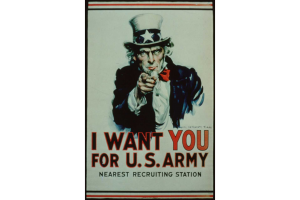United States of America

This World War I poster, by Stern in 1918, was published by the U.S. Treasury to convince U.S. citizens to buy government bonds to help fund the war efforts. The poster challenges United States citizens to prove that they are 100% American by buying the bonds and financially supporting the military. The graphics on this poster are very patriotic, the eagle, American flags, and cannons all help to catch the eye of working citizens that can afford to buy bonds and have them read the text. The United States did not have an immense number of troops on the ground overseas so a main way for citizens to aid in the war efforts. After the Great Depression, the United States and President Wilson saw the war as a chance to make the economy more stable and begin to move the U.S. into the position of power that it could achieve.

This World War I poster, created by James Montgomery Flagg in 1917, was made as a recruiting tactic for the United States Army. At the time, this poster would primarily be targeting young men to entice them to join the army and fight for their country. The representation of Uncle Sam pointing at “you” is attempting to trigger one’s patriotism and make them realize that they need to serve the United States. The beginning years of the war the U.S. did not have soldiers on the ground overseas, but by April of 1917 the U.S. had joined the Allied forces and started to send over troops. This poster was one of the first recruitment posters put out by the army and to this day is still one of the most iconic war posters in U.S. history. The United States did not institute a draft for World War I, so using posters and trying to reach out to men were their ways to gain involvement.
Australia

Published in Australia, this World War I poster was created by J. Newland and the State Recruiting Committee to increase the number of men that were enlisting in the military. With a much different approach than the U.S., this poster resembles an advertisement for war by promoting it as a free trip to Europe. Rather than triggering nationalism in the abled men in Australia, the plan for this poster was to be inviting and to represent the war as an adventure that would be the most memorable one of their lives. To receive the “invitation” to go on the trip to Europe to fight, all that the eligible men had to do was to go on a recruiting officer and apply. The poster also advertises that the men will be given money, food and clothing and also never makes any remarks of joining the military and fighting, this is all simply implied.
Britain

The Parliamentary Recruiting Committee created this leaflet in 1915 to send two messages to the people of Britain. The first message was to gain the attention of the citizens and have them remember the tragedy of the Lusitania being sunk by the Germans and the second message was to have men enlist in order to combat the Germans in honor of the ship. Using the letters S.O.S. to represent the last message of the Lusitania is very visible and makes the leaflet easy to grab one’s attention and show that soldiers are needed for the war. This propaganda is fairly similar to those of the U.S. in terms of the message it is trying to convey. This leaflet is very concise in its writing and gets the point across clearly. The recruiting committee uses a national tragedy as a way to convince people to join the military.
